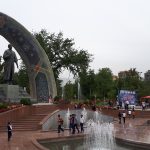The Tajik culture dates back thousands of years and even today, includes a variety of fascinating age-old traditions and customs. With a mix of ethnicities, religions, languages, and political views, the culture and traditions of Tajiks is a mix of everything yet still decidedly unique.
Most of the Tajikistan population are Muslim and this in turn has transformed and influenced the food, music, dress code, habits, and other traditions in Tajikistan. However, these all vary from region to region so while you may find one form of Tajik music or clothing in the north, you will very likely find something vastly different in the south of Tajikistan.
Music in Tajikistan
Similar to the rest of Central Asia, music plays a huge role in Tajikistan’s culture and national identity. Tajiks are known for their handmade musical instruments, predominantly string instruments like the rhubab, tanbur, and dutor as well as kettle drums like the tablak and tambourines like the doira. Many examples of these traditional musical instruments can be seen today in the various museums of Tajikistan, particularly the Musi Instrumental Gurminj.
While traditional music in Tajikistan varies from region to region, typical Tajik songs tend to be sung by just one person and the mood changes depending on the context it is played in. For example, the Tajikistan music you may hear around the village can be slow, melodic and somber while the songs played at a festival can be happy and upbeat. All of them involve some form of musical instrument, many of them several working together to create perfect harmony.
While the Arabic-influenced ‘shashmaqam’ is the main style of Tajik folk song, Tajikistan has a variety of other folk song styles. For example, the south of Tajikistan has its own form of folk music known as ‘falak’ that is played on special occasions, such as weddings and other celebrations.
Other Tajik folk song styles include ‘kuhestani’ in central Tajikistan and holiday songs played on national holidays that are usually accompanied by a dutar and doira. If you go further south towards Badakhshan near the Afghanistan border, the music blends into the north Afghan musical styles known for their spiritual ‘madah’ poetry.
Dancing in Tajikistan
Dancing in Tajikistan has had a vital role to play in centuries upon centuries of everyday life and Tajikistan tradition. Traditional Tajik dance was used prior to the Middle Ages to mark special occasions such as births and religious ceremonies.
Traditional Tajik dances span various cultures and regions. You will find a variety of traditional Tajikistan dances in the Pamirs, the Khatlon region, Hissar Valley, and Bukhara. They each have their own traditional costume and dance moves that emphasize the personality of each region.
Ancient Tajikistan dancing involved pantomime, circus and dramatic dances that imitated animals and birds. There were also ancient ceremonial dances such as the rakskhoi marosimi and dances to mark bereavements such as the poiamal. In keeping with Tajikistan’s male-oriented way of life, a man’s dance tends to be more hostile than a womans’ with sharper movements that signify power. They often involve weapons such as knives, fire and swords.
Clothing in Tajikistan
The traditional dress code in Tajikistan varies in terms of colors, patterns and styles according to the specific Tajik region in question.
However, the base wear is often the same across multiple cultures and religions. For example, the typical Tajikistan clothing for men usually involves a tunic-style knee-length shirt known as a pirahan or kamiz, drawstring trousers called tomban, and an embroidered skull cap known as a kolah. This is often combined with a quilted dressing gown, a waist scarf, and leather boots covered with pointy-toed galoshes.
Tajik traditional clothing for women usually involves a long-sleeved tunic-style dress, loose, straight-legged trousers, and a head scarf or skull cap that is often covered in brightly colored geometric or floral patterns. Generally, Tajik women wear one dress but on special occasions, they can wear up to seven dresses at once with vividly embroidered sleeves of differing lengths. Traditional Tajik jewelry is usually made of silver and any earrings, necklaces, or rings are always very large in size.
Interestingly, women still wear traditional dress in Tajikistan, whereas the men do not. The dress code is not for religious reasons, but it is modest and conservative. In the Tajik countryside, women tend to only wear traditional dress whereas women living in the city may mix these up with modern trends. The younger generation of Tajiks mostly wear pro-western style clothing. However, during spring and the Navruz celebration, women dress up in colorful dresses made from Atlas and Adras textiles.
While the dress code for tourists will be different from the Tajiki locals, visitors should still wear conservative and respectful clothes in Tajikistan, especially in the countryside and when visiting shrines and mosques.
Gender Roles in Tajikistan
As a predominately Muslim country, men are the powerful and authoritative figures in Tajikistan. They are the heads of the family and involved in all of the big decision-making while women are in charge of the home.
The Tajikistan constitution declares equal rights for both men and women. Despite this fact, while many women tend to hold jobs in the big cities, there are still some women living in rural areas whose husbands do not permit them to work or study.
Weddings and Marriages in Tajikistan
Finding a Muslim partner and starting a family is one of the most important parts of life in Tajikistan. The bride and groom are often matched by the parents or by common friends and relatives who take the role of matchmaker known as a ‘zavchi’. Once paired, they perform a courtship ritual known as ‘breaking bread’ after which the couple are considered officially engaged.
This is followed by the presentation of ‘kalym’ (a pay-off for the bride) that is made to her parents. Next, a Suzane coverlet is gifted as a sign of good fortune before the actual wedding ceremony, known as ‘nikokh’ takes place. On the wedding day, the villagers are all invited to eat together and they perform ceremonial rituals such as dancing, walking around fire, gifting of cups of flour (a sign of good fortune), and animal sacrifices.
Performing various post-wedding rituals are common traditions of Tajikistan, including the couple visiting the bride’s parents at specific periods after the wedding. Divorce is not a common part of typical Tajik traditions.
The culture and traditions of Tajiks varies from region to region and you can experience it all with a Paramount Journey tour. Take a look at our tours and itineraries or chat to us today to start planning your trip!













